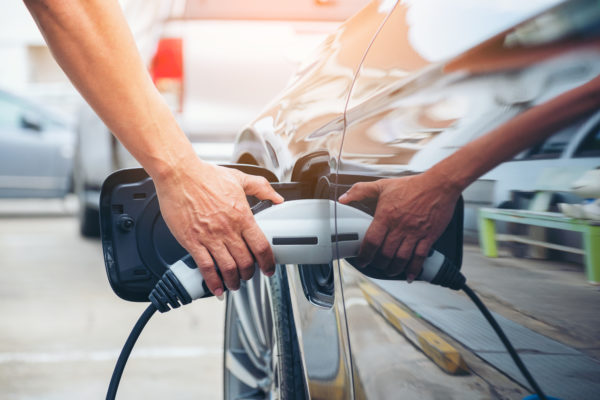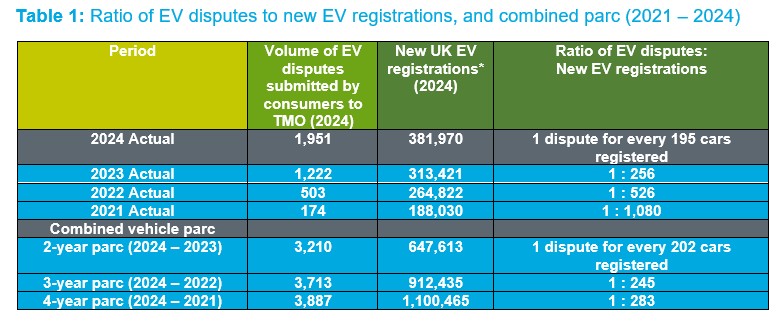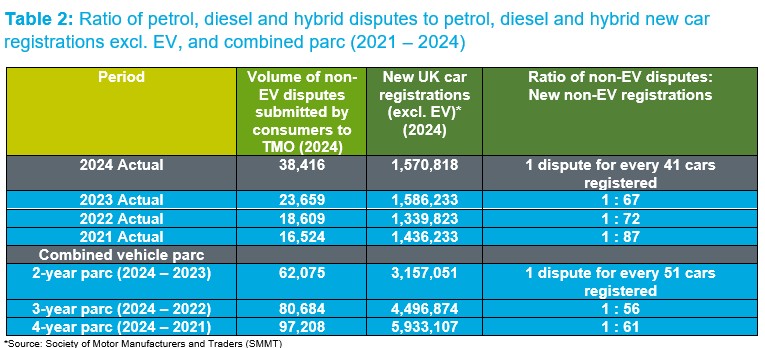EV disputes brought by consumers to The Motor Ombudsman in Q1 2025
Overview of EV disputes brought to The Motor Ombudsman relative to UK new car registrations and the overall automotive parc
Before presenting the profile and volume of electric vehicle (EV) disputes received by The Motor Ombudsman from consumers, it is important to understand the trend of EV disputes in relation to both EV and non-EV new car registrations (i.e. petrol, diesel and hybrid models), and the overall EV and non-EV vehicle parc.
When looking at the proportion of disputes received by The Motor Ombudsman versus new registrations on an annual basis for electric vehicles and non-electric models (i.e. petrol diesel and hybrid), as shown in Tables 1 and 2, it is possible to conclude that EVs generate far fewer complaints per vehicle than non-EV equivalents. For example, based on the latest 2024 full-year data, EVs were generating one dispute for every 195 cars, compared to one in every 41 vehicles for a petrol, diesel, or hybrid variant.
A similar picture can also be seen when comparing the volume of EV disputes to the combined car parc, with the two-year combined parc equating to one complaint in every 202 cars, extending to one in every 283 for the four-year combined parc. In contrast, for ICE and hybrid equivalent models, this rises to one dispute in every 51 cars for the two-year combined parc, and one in every 61 vehicles for the four-year combined parc, highlighting the variation between the powertrains.
For the first quarter of 2025, the ratio of EV disputes (641) received by The Motor Ombudsman to new EV registrations (120,191) equates to one dispute for every 244 new EVs registered.
Overview of EV disputes received in Q1 2025
In the first quarter of 2025, The Motor Ombudsman received a total of 641 disputes from consumers in relation to an electric vehicle. This equates to a 30% rise versus the same period in 2024 (492), which begins to mirror the proportion that new car registrations rose by in Q1 2025 versus Q1 2024 (i.e. 43%).
The first three months of 2025 also witnessed the highest quarterly tally of disputes to date, surpassing a total of 600 for the first time – once again reflective of the growing battery electric car parc and EV new car registrations in the UK (as shown in Table 3 below).
When looking at the main issues encountered by consumers with an EV during the first quarter of 2025, they are as follows:
1. Customer service and purchase issues (42%)
Customer service issues at the point of purchase or during ownership, made up nearly half, and the majority of the electric vehicle disputes logged with The Motor Ombudsman during the first quarter of 2025. These were driven by factors, such as delivery delays, vehicle specifications for new cars not meeting order forms at handover, spare keys not being provided to their new owners, and vehicles being damaged by businesses when on the ramp for repairs.
2. Chassis and motor issues (13%)
Mirroring the trend seen in previous quarters, concerns regarding the chassis and motor area of a vehicle accounted for the second largest volume of disputes seen between January and March. When it came to the suspension, there were corroding components, and leaking shock absorbers, whilst insulation faults plagued electric drive motors. Consumers equally logged complaints about wheels detaching from vehicles, and faulty tyre pressure sensors. Other causes for concern were namely, driveshaft failures, and the erroneous application of emergency braking systems.
3. Electrical and software issues (13%)
Electric faults were the third largest source of EV disputes in Q1, with power and lights failing whilst driving, faults preventing vehicles from starting, and errors stopping access to vehicles, amongst the issues which came to the fore. Similarly, as well as electrical and data connector faults caused by water ingress, car alarms being activated during the locking of vehicles, and continually sounding in the absence of any threat, also drove the occurrence of disputes.
The activation of software updates promoted concern due to them causing battery faults, and reducing charging capacity. In addition, an absence of any promised software updates by businesses equally drove dissatisfaction amongst EV owners.
4. Battery issues (9%)
Making up just under 10% of complaints in the opening quarter of 2025, faults with batteries and individual modules were one of the key areas of contention. Coolant leaks, and fast-draining batteries were also a principal source of consumer discontent.
5. Interior and cabin systems issues issues (7%)
The cabin area of an electric vehicle generated the fifth largest proportion of EV disputes. In-car functions, such as heated seats, and climate control systems were subject to faults, which proceeded to blow out hot air instead of cold, and causing windscreens to mist. Furthermore, vehicle owners expressed concern that digital interfaces and the vehicle’s DAB radio also stopped working correctly.
In terms of the ‘fabric’ of the interior, consumers reported fraying seat belts, and detaching seat coverings and stitching, with a similar issue affecting steering wheels, which also suffered from control malfunctions.
6. Exterior issues (6%)
The bodywork and associated fixtures drove 6% of EV disputes in the first quarter of 2025, with many of the principal issues raised stemming from the front and rear screens, sunroofs which were shattering, faulty screen seals, and the occurrence of holes in the glass. In addition to this, drivers were concerned about condensation forming in taillights, rusting on the inside of wheel arches, wiper blades detaching whilst driving, and boot spoiler motor faults.
7. Range issues (5%)
As seen previously in months of cooler weather, range concerns tend to increase as consumers draw more power to operate in-car systems, and may not always be aware of the impact on range. This leads to complaints of actual distances able to be travelled not conforming to those which were advertised, and a resulting perception that vehicles no longer meet the needs of their owners.
8. Charging issues (5%)
As an integral part of EV usage, not being able to use these systems to their full capacity can cause a high degree of inconvenience and lead to the occurrence of complaints. The replenishment of batteries was hindered by factors, such as delays to the start of the charging process, broken charging ports and flaps, not being able to charge to full capacity, and slow charging speeds.
Average consumer claim value
For consumers who stated a monetary value to resolve their complaint with a business, the average stood at £8,179 for Q1 2025, down 34% from the figure of £12,451 seen for the same three-month period in 2024.
To view and download the infographic below as a PDF, please click here.
To view and download The Motor Ombudsman’s thought leadership paper on electric vehicle disputes as a PDF, please click here.











